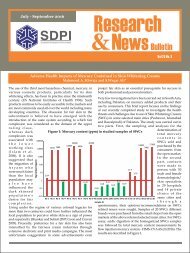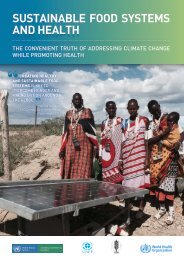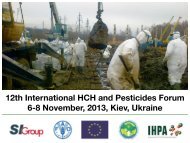Women and Chemicals
WomenAndChemicals_PublicationIWD2016
WomenAndChemicals_PublicationIWD2016
You also want an ePaper? Increase the reach of your titles
YUMPU automatically turns print PDFs into web optimized ePapers that Google loves.
Woman a agents of change<br />
less, if I didn’t also help the victims of the nuclear testing. So I decided<br />
to work with them <strong>and</strong> help them defend their ecological<br />
rights.” 9 Olga Speranskaya stresses, “only cooperation <strong>and</strong> global<br />
partnership, <strong>and</strong> comprehensive work will make a change. For communities<br />
impacted by chemical pollution in Kazakhstan, Georgia<br />
<strong>and</strong> Armenia, I try to make their lives a little bit better.” 10<br />
There is little research on the differences between men <strong>and</strong><br />
women regarding their engagement for environmental protection.<br />
A study 11 by Hemmati, shows there is some evidence that<br />
women are more environmentally aware <strong>and</strong> engage more in<br />
environmental issues, such as recycling, reuse <strong>and</strong> environmental<br />
friendly consumer behaviour, than do men. Yet more empirical<br />
research is needed in this area. Hemati links this difference also to<br />
the different gender roles of women <strong>and</strong> men with women being<br />
the main caretakers of their children <strong>and</strong> families, they are<br />
also more driven to protect them.<br />
A recent study, “More Work for Mother, Chemical Body Burdens<br />
as a Maternal Responsibility“ 12 , explores how women who<br />
are pregnant <strong>and</strong> mothers practice ‘precautionary consumption’<br />
to guard their child from environmental chemicals. Mackendrick<br />
concluded that „nearly all of the participants believed that precautionary<br />
consumption was primarily a mother’s responsibility, <strong>and</strong><br />
these women felt deeply responsible for their children’s health.“ It<br />
can be put forward as a hypothesis that women are more likely to<br />
change their consumption patterns to become more environmentally<br />
aware when they are planning or expecting a baby.<br />
<strong>Women</strong>’s environment NGOs such as WECF 13 receive many<br />
questions from consumers, almost all women, asking advice about<br />
hazardous chemicals <strong>and</strong> health. In response, WECF collaborates<br />
with scientists <strong>and</strong> responsible entrepreneurs to provide information<br />
via websites, APPs <strong>and</strong> consumer guides on, for example, toys,<br />
textiles, detergents <strong>and</strong> body care products. The WECF “Nesting”<br />
programme has recently been exp<strong>and</strong>ed to provide information to<br />
health <strong>and</strong> childcare professionals on how to avoid exposure to hazardous<br />
chemicals of children, as the health impacts are much greater,<br />
<strong>and</strong> often irreversible, than the same exposure levels for adults.<br />
That women have different priorities than men based on their<br />
different biology <strong>and</strong> gender roles does not mean that these priorities<br />
are not or less important. On the contrary, they are very important<br />
but often under-represented in policy decisions <strong>and</strong> mainstream<br />
media. <strong>Women</strong> should be empowerment to ensure their<br />
priorities are fully reflected in decision-making. More <strong>and</strong> more<br />
women have been assigned as environment ministers in recent<br />
years, with an average of 14 per cent in the last years, which is quite<br />
low, but still much higher than for other ministries such as finance<br />
of transport 14 . The Network of <strong>Women</strong> Ministers <strong>and</strong> Leaders for<br />
the Environment (NWMLW) was established during the 2009 UNEP<br />
Governing Council, to strengthen joint positions on gender equality<br />
in environmental policies 15 . Several women in policy making<br />
have taken the priorities of women on board to create policy<br />
change, including the European Commissioner for the Environment,<br />
Ms Margot Wallström, who was the driving force behind the<br />
ground-breaking chemicals EU Reg. No. 1907/2006 “REACH” 16 , with<br />
a focus on reducing health risks for children. Key persons are, inter<br />
alia, Lisa P. Jackson, Chief Administrator of the US Environmental<br />
Protection Agency who is committed to prevent exposure to toxic<br />
contamination focussing on vulnerable groups, including children,<br />
the elderly <strong>and</strong> low-income communities. Also Wangari Maathai,<br />
Nobel Peace Prize winner, <strong>and</strong> founder of the Green Belt Movement,<br />
who prioritised support for local women’s groups to plant<br />
forests, – which she called the “water towers” – thus protecting<br />
against climate change, <strong>and</strong> at the same time ensuring income for<br />
the local communities from seedlings <strong>and</strong> building materials.<br />
<strong>Women</strong> are agents of change <strong>and</strong> should be empowered to<br />
advance their priorities for a toxic-free environment, as policy<br />
makers, consumers, civil society activists or researchers, <strong>and</strong> often<br />
independent of the motivation to respond to own needs,<br />
rather focussing on the priorities of other women, or that of children,<br />
family members or society as a whole.<br />
Endnotes chapter<br />
5<br />
1 Universal Declaration of Human Rights, 1948 (see: http://www.<br />
un.org/en/documents/udhr/).<br />
2 Convention on the Elimination of All Forms of Discrimination Against<br />
<strong>Women</strong> (CEDAW), 1979 (see: http://www.un.org/womenwatch/daw/<br />
cedaw/).<br />
3 The 2012 World Development Report on Gender Equality <strong>and</strong><br />
Development (see: http://econ.worldbank.org/WBSITE/EXTERNAL/<br />
EXTDEC/EXTRESEARCH/EXTWDRS/EXTWDR2012/0,,contentMDK:229<br />
99750~menuPK:8154981~pagePK:64167689~piPK:64167673~theSite<br />
PK:7778063,00.html )<br />
4 EC, Special Eurobarometer 295, Report: Attitudes of European<br />
Citizens Towards the Environment, 2008 (see: http://ec.europa.eu/<br />
public_opinion/archives/ebs/ebs_295_en.pdf).<br />
5 Carson, R., Silent Spring, Boston 2002.<br />
6 Steingraber, S., Living Downstream, 2010 second edition.<br />
7 See Endnote vi.<br />
8 See for quote here: http://www.youtube.com/<br />
watch?v=eROrNGFr0yw (retrieved April 2014).<br />
9 See for quote here: http://www.goldmanprize.org/2005/asia (retrieved<br />
April 2014).<br />
10 See for quote here: http://www.goldmanprize.org/2009/europe<br />
(retrieved April 2014).<br />
11 Hemmati, M., Gender-Specific Patterns of Poverty <strong>and</strong> (Over-)<br />
Consumption in Developing <strong>and</strong> Developed Countries, in: E. Jochem,<br />
J. Sathaye <strong>and</strong> Daniel Biulle (Eds.): Society, Behaviour, <strong>and</strong> Climate<br />
Change Mitigation. Proceedings of IPCC Expert Group Meeting on<br />
Social Scientific Approaches to Climate Change Mitigation, 2000.<br />
12 Mackendrick, N., More Work for Mother: Chemical Body Burdens as a<br />
Maternal Responsibility, in: Gender & Society, October 2014, vol. 28<br />
no. 5, pg. 705-728.<br />
13 <strong>Women</strong> in Europe for a Common Future is an international network<br />
of women’s <strong>and</strong> environment organisations taking action for a<br />
healthy environment <strong>and</strong> sustainable development (see here: http://<br />
www.wecf.org).<br />
14 IUCN, Environment Gender Index: <strong>Women</strong> in Environmental Decision<br />
Making, 2013 (see: http://gender<strong>and</strong>environment.org/egi/).<br />
15 See here: http://www.unep.org/GC/GC25/nwmle.asp.<br />
16 Reg. No. 1907/2005 of 18 December 2006 „Registration, Evaluation,<br />
Authorisation <strong>and</strong> Restriction of <strong>Chemicals</strong> (REACH)“.<br />
47







